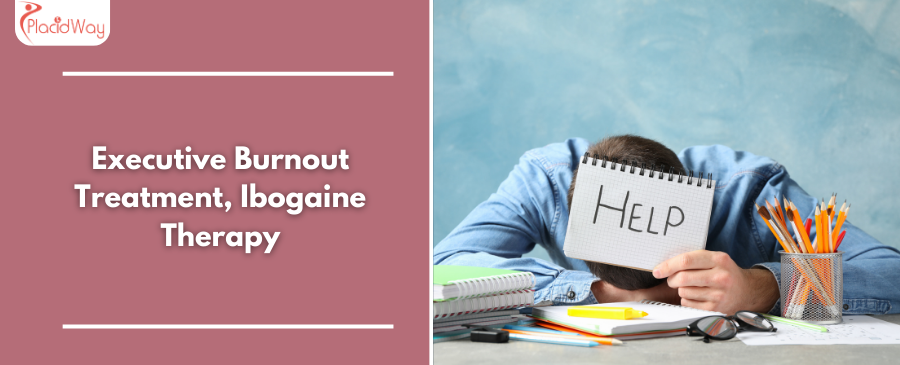
Reclaim Your Drive: Innovative Executive Burnout Treatment with Ibogaine Therapy Abroad
In the relentless pursuit of success, executives often push their limits, leading to a debilitating state known as executive burnout. This isn't just everyday stress; it's a profound mental, emotional, and physical exhaustion that can severely impact decision-making, productivity, and personal well-being. For many high-achievers globally, traditional therapies may offer temporary relief but struggle to address the deep-seated patterns of chronic stress and depletion.
As you search for "burnout recovery for high-achievers" or "executive mental health solutions," you might encounter groundbreaking treatments like Ibogaine therapy. Known for its potential to facilitate deep psychological insights and neural reset, Ibogaine is emerging as a compelling option for those seeking a more profound, lasting solution to executive burnout. Often accessed in specialized clinics abroad, this unique therapy can help executives break free from the cycle of exhaustion, regain focus, and reignite their passion and purpose.
This comprehensive guide explores executive burnout, delves into how Ibogaine therapy works, and explains why medical tourism for this treatment is becoming a preferred choice for professionals looking to make a significant change. We'll cover everything from symptoms and causes to costs, recovery, and what to expect when embarking on this transformative journey overseas.
What are the clear signs you're experiencing executive burnout?
Recognizing executive burnout can be challenging, as high-achievers often push through discomfort. However, the signs are distinct and pervasive. You might search for "signs of executive burnout" or "leadership burnout symptoms" when these feelings start to become overwhelming. Key indicators include:
- Chronic Exhaustion: Feeling constantly tired, even after rest, and a profound lack of energy that no amount of sleep seems to fix.
- Cynicism and Detachment: A growing sense of negativity towards work, colleagues, and even personal interests. You might feel emotionally numb or detached.
- Reduced Efficacy: Despite working long hours, your productivity declines, and you struggle to concentrate, make decisions, or feel effective in your role.
- Cognitive Impairment: Difficulty focusing, memory lapses, and a general fogginess that makes complex problem-solving arduous.
- Physical Symptoms: Frequent headaches, digestive issues, sleep disturbances (insomnia or hypersomnia), muscle pain, and a weakened immune system.
- Irritability and Impatience: A shorter fuse with colleagues, family, or even minor inconveniences, leading to strained relationships.
- Loss of Motivation: What once excited you now feels like a chore, and you've lost your drive or passion for your work.
- Withdrawal: Isolating yourself from social activities, colleagues, and even loved ones.
If these symptoms resonate, it's a strong signal that you need to address your well-being proactively.
Why do executives experience burnout, and what are the main causes?
Understanding the "causes of executive burnout" is crucial for effective treatment. While general stress is common, executives face unique pressures that amplify the risk:
- Excessive Workload and Long Hours: The expectation to be "always on," often working 60+ hours a week, with little downtime.
- High Stakes and Responsibility: Carrying the weight of critical decisions, financial outcomes, and employee livelihoods, leading to constant pressure.
- Lack of Control: Despite high positions, executives can feel a lack of control over certain processes, company direction, or external market forces.
- Unclear Expectations: Ambiguous roles or constantly shifting priorities can lead to a feeling of being perpetually overwhelmed and ineffective.
- Lack of Support and Recognition: Even at the top, a lack of appreciation or adequate support systems can lead to feelings of isolation and being undervalued.
- Mismatch in Values: Working for an organization whose values conflict with your own can create deep internal friction and moral distress.
- Poor Work-Life Balance: The relentless demands of an executive role often erode personal time, hobbies, and family life, eliminating crucial avenues for recovery.
- Perfectionism and Imposter Syndrome: Internal pressures to always perform flawlessly, coupled with a fear of being "found out" as inadequate, create immense internal stress.
These factors, combined, create a fertile ground for burnout, eroding mental resilience over time.
How can Ibogaine therapy offer a path to recovery from executive burnout?
When searching for "innovative burnout treatments" or "Ibogaine for mental health," you'll discover its unique mechanism. Ibogaine, derived from the root bark of the Tabernanthe iboga plant, is not a conventional therapy. It's a powerful psychoactive compound that interacts with multiple neurotransmitter systems in the brain.
For executive burnout, Ibogaine is believed to work in several ways:
- Neurobiological Reset: It can help "reboot" the brain's reward systems and neural pathways, potentially reducing chronic stress responses and anxiety. Many patients report a sense of mental clarity and calm post-treatment.
- Deep Introspection and Insight: During the acute phase, Ibogaine often induces a dream-like state, allowing individuals to revisit past experiences, emotional traumas, and behavioral patterns from a detached perspective. This can provide profound insights into the root causes of their burnout and stress responses.
- Interrupting Negative Cycles: By facilitating this deep self-reflection, Ibogaine can help break cycles of rumination, self-criticism, and overthinking common in high-pressure roles.
- Emotional Processing: It offers an opportunity to process suppressed emotions and unburden psychological weight, which is often a significant contributor to chronic exhaustion.
- Increased Neuroplasticity: Some research suggests Ibogaine can promote neuroplasticity, potentially making the brain more receptive to new, healthier patterns of thinking and behaving after the experience.
Unlike traditional therapies, Ibogaine therapy is typically a single, intense session followed by a period of integration and aftercare, aiming for a significant shift rather than incremental progress.
Who is an ideal candidate for Ibogaine treatment for executive burnout?
While Ibogaine holds promise, it's not for everyone. Patients often search for "Ibogaine eligibility" or "who can take Ibogaine." The selection process is rigorous to ensure safety and maximize efficacy. Ideal candidates typically meet the following criteria:
- Severe and Persistent Burnout: Individuals who have experienced significant, prolonged executive burnout, often resistant to conventional therapies like psychotherapy or medication.
- Commitment to Change: A genuine desire and readiness for deep self-reflection and personal transformation. Ibogaine is a tool, not a magic bullet; the patient's commitment to integration is key.
- Good Physical Health: This is paramount. Candidates undergo thorough medical screening, including cardiac evaluations (ECG), liver function tests, and blood work, to rule out contraindications. Ibogaine can affect the heart, so any pre-existing cardiac conditions (e.g., long QT syndrome) are absolute disqualifiers.
- No Contraindicating Medications: Certain medications, especially psychiatric ones, must be tapered off well in advance under medical supervision, as they can interact dangerously with Ibogaine.
- Mental Stability: While it addresses mental health, active psychosis, severe bipolar disorder, or specific personality disorders might preclude treatment, as the intense introspective experience could be overwhelming.
- Support System: Having a supportive network for post-treatment integration is highly beneficial.
A comprehensive medical and psychological assessment by a qualified Ibogaine provider is essential to determine suitability.
What does the recovery process look like after Ibogaine therapy for burnout?
The "recovery time for Ibogaine therapy" is multifaceted, extending far beyond the immediate post-treatment period. It's often described in stages:
- Acute Phase (24-72 hours): Immediately after the main dose, patients enter an introspective, dream-like state. This is followed by a period of rest and physical recovery as the body processes the substance. You may experience some fatigue, nausea, or mild tremors, which are carefully managed by clinic staff.
- Integration Phase (Weeks to Months): This is the most critical part of the recovery, where the profound insights gained during the Ibogaine experience are integrated into daily life. This period requires:
- Therapeutic Support: Working with therapists, coaches, or counselors skilled in psychedelic integration is highly recommended to process the experience and develop new coping mechanisms.
- Self-Care: Prioritizing rest, nutrition, gentle exercise, and mindfulness practices. Avoid jumping straight back into the high-stress environment that caused burnout.
- Lifestyle Changes: Making conscious choices about work-life balance, boundary setting, and pursuing activities that bring joy and meaning.
- Patience: Transformation is a process. It's important to be patient with yourself and understand that lasting change takes time and effort.
- Long-term Well-being: Many executives report a renewed sense of purpose, improved emotional regulation, and enhanced clarity that helps them navigate future challenges without falling back into burnout patterns.
Successful recovery hinges on diligent aftercare and a commitment to integrating new perspectives into sustainable lifestyle changes.
What are the potential risks and side effects of Ibogaine therapy?
While Ibogaine can be transformative, it is a powerful substance with potential "Ibogaine risks and side effects" that demand serious consideration and medical supervision. This is why treatment is typically conducted in specialized, medically equipped clinics:
- Cardiac Complications: This is the most serious risk. Ibogaine can prolong the QT interval, potentially leading to dangerous cardiac arrhythmias (Torsade de Pointes) or bradycardia. Thorough pre-screening, continuous cardiac monitoring during treatment, and the presence of trained medical staff are crucial.
- Seizures: Although rare, seizures can occur, especially in individuals with a history of epilepsy or those undergoing withdrawal from certain substances.
- Nausea and Vomiting: Very common during the initial phase of treatment. Anti-emetics are usually administered to manage this.
- Ataxia (Loss of Coordination): Patients will experience difficulty with movement and balance during the acute phase, requiring assistance.
- Anxiety and Psychological Distress: The intense introspective experience can be emotionally challenging, potentially leading to anxiety or fear. Proper psychological preparation and a supportive environment are vital.
- Dehydration and Electrolyte Imbalance: Due to nausea and vomiting, careful monitoring and hydration are necessary.
- Fatigue: Profound fatigue can last for several days after the main experience.
It cannot be stressed enough: Ibogaine therapy should *never* be attempted without comprehensive medical evaluation and ongoing professional supervision in a clinical setting.
Why consider traveling abroad for executive burnout and Ibogaine treatment?
The decision to seek "executive burnout treatment abroad" or "Ibogaine therapy overseas" is driven by several compelling factors for discerning professionals:
- Legal Status and Accessibility: Ibogaine is illegal or heavily restricted in many Western countries (e.g., USA, Canada, UK, Australia) due to its Schedule I classification. Clinics in countries where it is legal and regulated (e.g., Mexico, Costa Rica, some parts of Europe) offer safe, accessible treatment options.
- Specialized Expertise: Many international clinics have decades of experience administering Ibogaine safely and effectively, with protocols refined for various conditions, including burnout. They often have multidisciplinary teams, including medical doctors, nurses, therapists, and integration specialists.
- Holistic and Integrative Approach: Overseas clinics often combine Ibogaine therapy with pre-treatment preparation, psychological counseling, nutritional support, meditation, and post-treatment integration, offering a comprehensive path to healing.
- Privacy and Discretion: For executives, privacy is paramount. Traveling abroad allows for a discreet treatment away from public scrutiny, professional obligations, and familiar triggers, fostering a complete break from the environment that contributed to burnout.
- Cost-Effectiveness: In many cases, the total cost of high-quality Ibogaine treatment abroad, including travel, can be more affordable than limited options available in one's home country, if any.
- Environment for Healing: Being in a new, often tranquil environment can be incredibly therapeutic in itself, facilitating deeper introspection and a fresh perspective away from daily stressors.
For those seeking a transformative experience away from their ordinary world, medical tourism provides a unique opportunity.
How much does Ibogaine therapy for executive burnout cost worldwide?
The "cost of Ibogaine treatment" is a significant consideration for many. It's important to understand that these prices generally reflect comprehensive programs that include medical screening, the Ibogaine session itself, medical supervision, accommodation, meals, and often pre- and post-treatment support. The cost can vary widely based on:
- Country: Labor costs, operational expenses, and regulatory environments differ.
- Clinic Reputation and Services: Highly reputable clinics with extensive medical staff, luxurious accommodations, and robust aftercare programs will naturally be more expensive.
- Program Length: While the Ibogaine session itself is acute, programs often last 5-10 days, or even longer for full integration support.
- Inclusions: Some packages are all-inclusive, covering airport transfers, gourmet meals, complementary therapies (e.g., massage, yoga), and psychotherapy sessions.
| Country | Estimated Cost Range (USD) | Key Factors Influencing Cost |
|---|---|---|
| Mexico | $6,000 - $12,000+ | Proximity to USA, well-established clinics, varying levels of luxury and medical support. |
| Costa Rica | $7,000 - $15,000+ | Focus on holistic healing, natural settings, high-quality medical oversight. |
| Europe (e.g., Portugal, Netherlands) | $8,000 - $18,000+ | Strict regulations, often higher-end medical facilities, integration with psychotherapy. |
| Africa (e.g., Gabon, South Africa) | $5,000 - $10,000+ | Often more traditional or retreat-style settings, costs vary widely based on clinic. |
*Prices are estimates and subject to change. Always confirm directly with clinics for exact costs and package details.
Which countries are best known for safe and effective Ibogaine therapy?
When researching "best countries for Ibogaine therapy" or "safe Ibogaine clinics abroad," a few regions consistently stand out due to their established infrastructure, legal frameworks, and experienced practitioners:
- Mexico: Particularly areas near the US border (like Tijuana) and coastal regions, have a long history of offering Ibogaine treatment. Many clinics are run by experienced medical professionals with strong safety protocols and a focus on both physical and psychological support. Its accessibility for North American patients is a major draw.
- Costa Rica: Known for its beautiful, natural settings, Costa Rica has also become a hub for holistic Ibogaine treatment. Clinics here often emphasize a retreat-like experience, combining advanced medical care with wellness practices and integration support in tranquil environments.
- Portugal: While Ibogaine's legal status is nuanced, Portugal is known for its progressive drug policies and has some clinics that operate within specific legal frameworks, offering high-quality medical care.
- Other European Countries: Certain European nations, like the Netherlands, also have highly regulated and medically advanced clinics, though they might be fewer in number.
To "ensure safety and quality abroad," always look for clinics that:
- Have a licensed medical doctor (MD) on staff, ideally an anesthesiologist or emergency physician.
- Provide continuous cardiac monitoring (ECG) throughout the treatment.
- Conduct thorough pre-screening, including blood tests and medical history.
- Offer a clean, comfortable, and medically equipped facility.
- Have a clear protocol for emergencies.
- Provide robust pre- and post-treatment psychological support.
- Are transparent about their staff's qualifications and success rates.
What are patient success stories and expectations when seeking Ibogaine treatment abroad?
While individual results vary, "patient success stories for Ibogaine" often highlight profound shifts. Executives who have undergone Ibogaine therapy for burnout frequently report:
- Renewed Mental Clarity: A feeling of having a "clean slate" mentally, with reduced brain fog and enhanced focus.
- Emotional Regulation: Improved ability to manage stress, anxiety, and emotional reactivity, leading to greater calmness.
- Return of Motivation and Purpose: Reconnecting with their drive, passion, and a clearer sense of direction in both their professional and personal lives.
- Breaking Cycles: Identifying and breaking free from self-defeating thought patterns and behaviors that contributed to burnout.
- Increased Resilience: A greater capacity to handle pressure without relapsing into chronic stress.
One executive, let's call him Mark, a CEO from New York, described his experience: "I felt like I was running on fumes for years. Ibogaine in Costa Rica gave me an intense, humbling experience that allowed me to see where I was truly depleted. I came back feeling lighter, clearer, and with a renewed sense of purpose, not just for my company, but for my life."
When planning your journey for "medical travel for mental health," especially for Ibogaine, set realistic expectations:
- It's not a magic bullet: Ibogaine provides a powerful opportunity for change, but the integration work you do afterward is crucial for long-term success.
- The experience can be challenging: The introspective journey can be intense and sometimes difficult, confronting past traumas or negative patterns.
- You need downtime: Don't expect to jump back into a demanding schedule immediately. Allow ample time for rest, reflection, and integration upon return.
- Support is key: Utilize the aftercare support offered by the clinic and seek out independent integration therapy to maximize your outcomes.
Ibogaine therapy can be a pivotal step for executives ready to confront burnout head-on and embark on a path to sustainable well-being and peak performance.
Take the Next Step with PlacidWay
Ready to explore treatment options abroad? Discover top clinics, compare prices, and get a free quote tailored to your needs with PlacidWay.


-Package-in-Kuala-Lumpur,-Malaysia-by-FirstCell.jpg)







Share this listing